- Publisher's Note
- Editorial
- The Enigma That was Souza
- Progressive Art Group Show: The Moderns
- The Souza Magic
- M.F. Husain: Other Identities
- From All, One; And From One, All
- Tyeb Mehta
- Akbar Padamsee: The Shastra of Art
- Sensuous Preoccupations of V.S. Gaitonde
- Manishi Dey: The Elusive Bohemian
- Krishen Khanna: The Fauvist Progressive
- Ram Kumar: Artistic Intensity of an Ascetic
- The Unspoken Histories and Fragment: Bal Chhabda
- P. A. G. and the Role of the Critics
- Group 1890: An Antidote for the Progressives?
- The Subversive Modernist: K.K.Hebbar
- Challenging Conventional Perceptions of African Art
- 40 Striking Indian Sculptures at Peabody Essex Museum
- Tibetan Narrative Paintings at Rubin Museum
- Two New Galleries for the Art of Asia opens at the Museum of Fine Arts in Boston
- Raphael, Botticelli and Titian at the National Gallery of Australia
- The Economics of Patronization
- And Then There Was Zhang and Qi
- What Happened and What's Forthcoming
- Random Strokes
- Yinka Shonibare: Lavishly Clothing the Somber History
- A Majestic “Africa”: El Anatsui's Wall Hangings
- The Idea of Art, Participation and Change in Pistoletto’s Work
- On Wings of Sculpted Fantasies
- The Odysseus Journey into Time in the Form of Art
- On Confirming the Aesthetic of Spectacle: Vidya Kamat at the Guild Mumbai
- Dhiraj Choudhury: Artist in Platinum Mode
- Emerging from the Womb of Consciousness
- Gary Hume - The Indifferent Owl at the White Cube, London
- Daum Nancy: A Brief History
- Experimenting with New Spatial Concepts – The Serpentine Gallery Pavilion Project
- A Rare Joie De Vivre!
- Art Events Kolkata-December 2011– January 2012
- Art Bengaluru
- Mumbai Art Sighting
- Delhi Dias
- Musings from Chennai
- Preview, February, 2012- March, 2012
- In the News-January 2012
ART news & views
On Wings of Sculpted Fantasies
Issue No: 25 Month: 2 Year: 2012
Review
by Haimanti Dutta Ray
The new century has brought in its wake newer thoughts, perceptions and hence, newer ways of their final and ultimate execution. Art can hardly be left behind or considered in isolation. Strictly adhering to the regulations of art schools and following well-trodden paths which have been experimented with time and time again, is a phenomenon that has been left behind along with other things in the past century. As early as in the nineteenth century, Schopenhauer claimed that “the world is my representation”, and Nietzsche, sixty years after him, decreed that “there are no facts, there are only interpretations.” Their philosophy holds true even in the twenty-first century. What we see around us are but interpretations and representations of reality, the naked image of which lie hidden to the human eye.
Indian contemporary art at the break of the twenty-first century is as varied as it had never been before. From the elitist business houses and royal families, it has now entered the drawing rooms of the middle class buyers and from domestic markets, it is travelling offshore to fetch immense often astronomical prices. Instead of being restricted to a single medium, artists in the present century are experimenting with various media simultaneously. The distinction between paintings, assemblages, installations, collages and sculptures is getting blurred with each passing day. Art in India had always been an integral part of Indian life and excavations of art objects from historical places have shown that Indian art had reached a very high degree of sophistication and abstraction at various times in Indian history. Many of the artists in the twenty-first century use these historical styles in their art. Similarly there are artists who draw their inspiration from folk traditions of our country. While contemporary artists in India take inspiration from various sources and styles, Indian art still retains its distinct Indianness. Newer styles never seen before are also emerging in the Indian art scene; forms and styles which actually cannot be categorized into any specific existing genre.
Sculpture is a three-dimensional artistic experience created by shaping or combining hard materials - typically stone such as marble - or metal, glass or wood. Softer ('plastic') materials can be used such as clay, textiles, plastics, polymers and softer metals. The term has been extended to works including sound, text and light. Materials may be worked by removal such as carving or they may be assembled such as welding, hardened such as firing or molded or cast. Surface decoration such as paint may also be applied. Sculpture has been described as one of the 'plastic arts' because it can involve the use of materials that can be molded or modulated. It is an important part of public art. Many sculptors share a common grievance - that they are not accorded similar status given to painters. But that would be an unfair supposition.
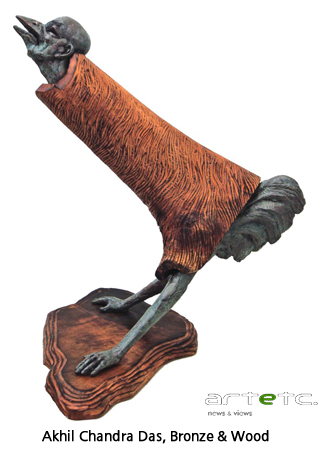
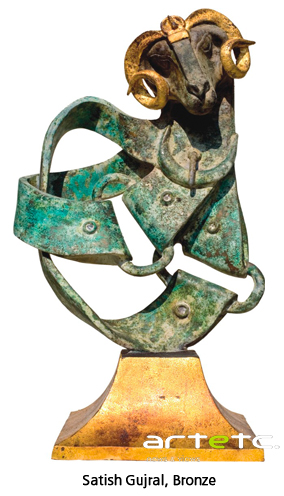 That sculptors are serious artists to reckon with, was proven by the sculpture exhibition organized by and held at Aakriti Art Gallery from 12th January to be showcased to the end of the month. A Dense Web of Balances proved beyond any spec of human doubt that all sculptors are artists, but not all artists are sculptors. There were as many as twenty artists exhibiting their works in this show. They have (with the exception of a few) worked with conventional media for the execution of their artistic self. What came out after
That sculptors are serious artists to reckon with, was proven by the sculpture exhibition organized by and held at Aakriti Art Gallery from 12th January to be showcased to the end of the month. A Dense Web of Balances proved beyond any spec of human doubt that all sculptors are artists, but not all artists are sculptors. There were as many as twenty artists exhibiting their works in this show. They have (with the exception of a few) worked with conventional media for the execution of their artistic self. What came out after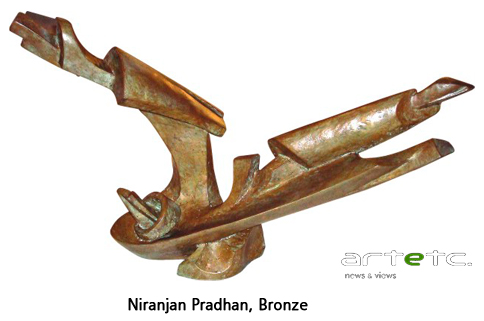 viewing the show, was the fact that man is very much a social entity and cannot be regarded or treated in isolation. Sunanda Das - War- Neurotic (Bronze) showed human figures wrestling with each other. The fact that he is at war with others as well as with himself was exemplified. Satish Gujral's two works, both Untitled (Bronzes) showed a figure riding a bull in one, which reminded one of Spanish matador fights, while the other showed the head of an ox but with locks, bolts and keys that formed its body structure. Akhil Chandra Das also gave two works - Untitled (both wood and bronze) showed his signature figure of the old man who holds the weight of the world on his shoulders, akin to the King of the Roman gods, Zeus. In one, he carries four birds (emblems of peace and hope) and in the other, he is shaped like a hen whose hands form the paws and on his behind are plumes of feathers.
viewing the show, was the fact that man is very much a social entity and cannot be regarded or treated in isolation. Sunanda Das - War- Neurotic (Bronze) showed human figures wrestling with each other. The fact that he is at war with others as well as with himself was exemplified. Satish Gujral's two works, both Untitled (Bronzes) showed a figure riding a bull in one, which reminded one of Spanish matador fights, while the other showed the head of an ox but with locks, bolts and keys that formed its body structure. Akhil Chandra Das also gave two works - Untitled (both wood and bronze) showed his signature figure of the old man who holds the weight of the world on his shoulders, akin to the King of the Roman gods, Zeus. In one, he carries four birds (emblems of peace and hope) and in the other, he is shaped like a hen whose hands form the paws and on his behind are plumes of feathers.
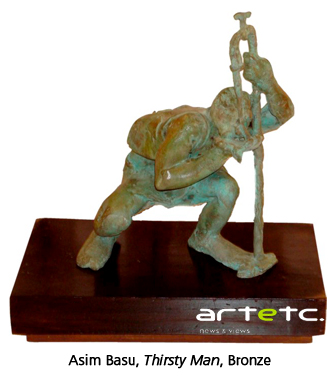 The veteran sculptor, Niranjan Pradhan, also gave two compositions for this show. Both were in bronze. In Visitor's View, we find his philosophy that man is but miniscule in the greater cosmic order of things. It could also be interpreted as the viewers watching the magic of the white cube gallery space. In a recent exhibition, the sculptor had experimented with the installation format. But here he has stuck to convention. Asim Basu's two works in bronze - Thirsty Man showed the figure drinking with his hands cupped from the flow of a tap. In Patience, a battalion of unrecognizable human figures are standing, chatting, holding umbrellas. They made a pretty picture of camaraderie and joie de vivre. Chandan Bhandari's two sculptures in stone and metal had marble slabs on which carvings or etchings had been made. In Sweet Prints, amidst the shape of an open seed, a metallic banana is held. In Personal Vehicles, a conceptualized image of a tiny helicopter rests on a marble platform. Shyamal Roy's Horse and Durga, bore the stamp of the artist who is a well-known name in the field of terracotta sculpture.
The veteran sculptor, Niranjan Pradhan, also gave two compositions for this show. Both were in bronze. In Visitor's View, we find his philosophy that man is but miniscule in the greater cosmic order of things. It could also be interpreted as the viewers watching the magic of the white cube gallery space. In a recent exhibition, the sculptor had experimented with the installation format. But here he has stuck to convention. Asim Basu's two works in bronze - Thirsty Man showed the figure drinking with his hands cupped from the flow of a tap. In Patience, a battalion of unrecognizable human figures are standing, chatting, holding umbrellas. They made a pretty picture of camaraderie and joie de vivre. Chandan Bhandari's two sculptures in stone and metal had marble slabs on which carvings or etchings had been made. In Sweet Prints, amidst the shape of an open seed, a metallic banana is held. In Personal Vehicles, a conceptualized image of a tiny helicopter rests on a marble platform. Shyamal Roy's Horse and Durga, bore the stamp of the artist who is a well-known name in the field of terracotta sculpture.

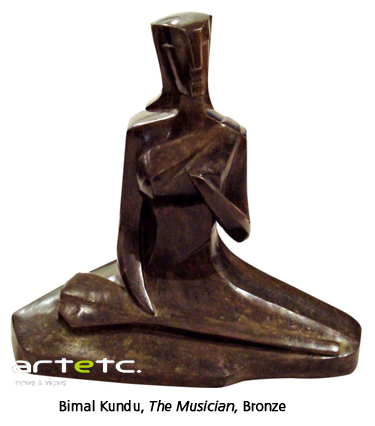 Shankar Ghosh's bronze sculptures - A Face and Arjuna- (both bronze) showed a pensive face held by a hand in the former and in the latter, the mythological figure with his bow and arrows. Sunil Kumar Das's bronzes - Untitled I and II showed elongated human figures, one man and the other woman, standing tall and straight. Subrata Biswas's Proximity (Bronze) showed a boy and a girl at close encounters with a touch of colour - patinated red - at the end of the plait of the girl. Tapas Biswas's Lunch Break (Brass) showed twelve heads sitting at a table, and as the title card suggests, they must be having lunch. Jayanta Paul's two Untitled works (wood and fibre glass) showed man performing various types of physical exercises. The touch of real colour in the entire show was added by the two ceramic works done by Pallab Das. In Bird, a very colourful owl has been sculpted with the use of the colours blue and green on its body, with dark red for its eyes to give the effect of gouged out eyes which are hence bleeding. In Head, Pallab has made an egg-shaped head with the tongue sticking out. The element of underplayed macabre was highly pronounced in these two works. Tapan Kumar Das's two works in bronze showed an extensive use of the patina. Manik Talukdar's Pharaoh (Bronze) was a masterly rendition from a veteran name in the field of Indian sculpture. The smell and essence of the Egyptian land and its antiquities seemed to emanate through and from his single work. Bimal Kundu's Musician and Head, both in bronze, showed the sculptor's signature fascination for chiseled, conical heads and figures.
Shankar Ghosh's bronze sculptures - A Face and Arjuna- (both bronze) showed a pensive face held by a hand in the former and in the latter, the mythological figure with his bow and arrows. Sunil Kumar Das's bronzes - Untitled I and II showed elongated human figures, one man and the other woman, standing tall and straight. Subrata Biswas's Proximity (Bronze) showed a boy and a girl at close encounters with a touch of colour - patinated red - at the end of the plait of the girl. Tapas Biswas's Lunch Break (Brass) showed twelve heads sitting at a table, and as the title card suggests, they must be having lunch. Jayanta Paul's two Untitled works (wood and fibre glass) showed man performing various types of physical exercises. The touch of real colour in the entire show was added by the two ceramic works done by Pallab Das. In Bird, a very colourful owl has been sculpted with the use of the colours blue and green on its body, with dark red for its eyes to give the effect of gouged out eyes which are hence bleeding. In Head, Pallab has made an egg-shaped head with the tongue sticking out. The element of underplayed macabre was highly pronounced in these two works. Tapan Kumar Das's two works in bronze showed an extensive use of the patina. Manik Talukdar's Pharaoh (Bronze) was a masterly rendition from a veteran name in the field of Indian sculpture. The smell and essence of the Egyptian land and its antiquities seemed to emanate through and from his single work. Bimal Kundu's Musician and Head, both in bronze, showed the sculptor's signature fascination for chiseled, conical heads and figures.
Sujit Kumar Karan's two terracotta works - Mark and Untitled - were hung, plastered or soldered to plastic frames , like paintings , hence giving a one-dimensional experience. One of Nantu Behari Das's head series, Untitled (metal screws) in this show, was there. The sculpture which caught the viewers' attention as soon as one stepped into the exhibition was Pradip Mondal's Nature II (bronze and steel) where the suspended steel ball hung by an almost invisible string in a whirligig of a sphere. It provided one with a sense of intended balance and also that of gravity. His other work - Nature I (bronze) - showed an egg-shaped vase, the egg being cracked at the vortex. The sculptor Uma Siddhanta's two works - Recline and The Lady - both in bronze, showed the celebration of the grace latent in the feminine form.
What emanated after viewing the sculpture exhibition was the fact that all the participating artists were at the crossroads of tradition and individual talent. Tradition and modernity are relative terms embedded in culture and related to space and time. All the sculptors have a long history of tradition behind them, but they have also incorporated a sense of individual finesse into each of their works.